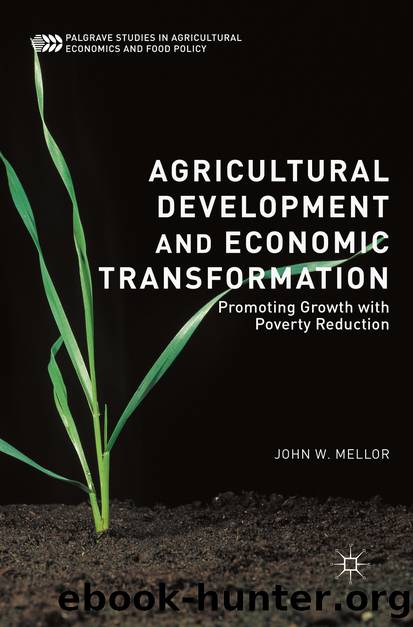Agricultural Development and Economic Transformation by John W. Mellor

Author:John W. Mellor
Language: eng
Format: epub
Publisher: Springer International Publishing, Cham
Rural Health Status
Globally, 93 percent of households using untreated surface water live in rural areas and 70 percent of those are without access to improved sanitation. Ninety percent of open defecation is in rural areas. Fifty percent of the global population is rural but 38 percent of nurses and 25 percent of physicians are in rural areas. Rural areas have worse health problems and less treatment. The greatest spread in the rural to urban incidence of illness is among young children. That obviously affects learning, both formal and informal. It should be noted that rural areas in high-income countries also have a lower density of nurses and physicians than urban areas. But rural people in high-income countries have better access to urban specialists.
Rural areas do have a faster growth rate than urban areas in improved water and sanitation, but at a low 0.6 and 0.3 percent growth rate, respectively. Again the point must be emphasized that rural infrastructure is important to both the spread of health facilities and the presence of nurses and doctors.
The incidence of unavailability to work due to illness is much higher in low- and middle-income countries than in high-income countries. That is not surprising given the widespread malnutrition and poor health facilities and knowledge. Even though there is substantial underemployment, illness has a negative effect on production through its impact on family labor for which replacement is often not possible due to a cash constraint on hiring labor and the inefficiencies of hired labor. Onset of poor health is one of the most important risk factors with respect to income in rural areas of low- and middle-income countries. The social suffering from illness is immense in low-income families that are close to the margin of subsistence.
Investment in physical infrastructure will improve access to health facilities. The reduction in poverty from rapid agricultural growth will increase nutritional status, particularly in reducing lack of calories. All these elements interact with the health institutions to increase the returns to those institutions.
Modernization brings increased returns to the use of pesticides and with that a rapidly increasing use. Because pesticide use on farms is essentially unregulated in low- and middle-income countries the negative effect on health is substantial and that in turn has a negative effect on agricultural productivity (Antle and Pingali 1994). At the very least, research and extension must focus on this problem and increase the extension input.
Download
This site does not store any files on its server. We only index and link to content provided by other sites. Please contact the content providers to delete copyright contents if any and email us, we'll remove relevant links or contents immediately.
International Integration of the Brazilian Economy by Elias C. Grivoyannis(90763)
The Radium Girls by Kate Moore(11921)
Turbulence by E. J. Noyes(7935)
Nudge - Improving Decisions about Health, Wealth, and Happiness by Thaler Sunstein(7615)
The Black Swan by Nassim Nicholas Taleb(7010)
Rich Dad Poor Dad by Robert T. Kiyosaki(6399)
Pioneering Portfolio Management by David F. Swensen(6226)
Man-made Catastrophes and Risk Information Concealment by Dmitry Chernov & Didier Sornette(5921)
Zero to One by Peter Thiel(5684)
Secrecy World by Jake Bernstein(4643)
Millionaire: The Philanderer, Gambler, and Duelist Who Invented Modern Finance by Janet Gleeson(4374)
The Age of Surveillance Capitalism by Shoshana Zuboff(4209)
Skin in the Game by Nassim Nicholas Taleb(4161)
Bullshit Jobs by David Graeber(4094)
The Money Culture by Michael Lewis(4075)
Skin in the Game: Hidden Asymmetries in Daily Life by Nassim Nicholas Taleb(3929)
The Dhandho Investor by Mohnish Pabrai(3698)
The Wisdom of Finance by Mihir Desai(3650)
Blockchain Basics by Daniel Drescher(3499)
